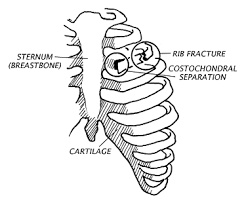First aid- Rib Injury :
Structure of the ribs:
The ribcage consists of 24 curved ribs arranged in 12 pairs. Each pair is attached to a vertebra in the spine. At the front of the body, the first seven pairs of ribs are attached directly to the sternum (breastbone) by cartilage known as costal cartilage. These ribs are often called ‘true ribs’.
The next three pairs of ribs aren’t connected to the sternum. Instead, costal cartilage attaches these ‘false ribs’ to the last pair of true ribs. The remaining two pairs aren’t attached at the front of the body at all and are known as ‘floating ribs’.
The ribcage is supported by ligaments and muscles, including the muscles between the ribs (intercostal muscles). These muscles allow the ribcage to expand when you breathe in and to drop when you breathe out.
The ribcage supports the upper body, protects internal organs, including the heart and lungs, and assists with breathing. Rib injuries include bruises, torn cartilage and bone fractures. Chest trauma may also cause life-threatening injuries such as a punctured lung or a ruptured aorta.
Common causes of rib injury include motor vehicle accidents and falls. Treatment aims to relieve pain while the injury heals.
The ribs are fairly resistant to injury, but sometimes accidents happen. The most common injury is a rib fracture, and these are more commonly found in adults. The reason for this is that children have more elasticity in their bones, which causes them to break less easily. Another common injury to the ribs is muscle strains.
Rib fractures:
Rib Fractures are usually caused by a direct blow (or fall) to the ribs. Ribs 4-9 are the most commonly broken because they would receive the most pressure in the event of a direct blow. The following are symptoms of a broken rib:
- Severe localized pain
- Sharp pain with any motion of the chest (breathing, coughing, sneezing, laughing).
- See your doctor if any of the following things occur, as they may indicate complications from the fracture such as a pierced lung.
- You become short of breath, or your breathing is labored and difficult.
- You become lightheaded.
- The area swells.
- When the injured area (place where the pain is greatest) is gently pressed a “crunching” sound is heard.
- The pain seems very severe or “deep”.
- There is pain in your abdomen.
- You are coughing up blood.
- There is blood in your urine.
Remember, if you are unsure if you have broken a rib you should see a doctor to make sure. Also keep in mind that about 25% of rib fractures will not show up on an x-ray. These injuries cannot be cast, due to their position, but to ease the pain and discomfort a elastic ace bandage may be wrapped around the persons chest. If you are able to continue doing most of your everyday activities with only minimal pain it’s a good sign. If there is a deep pain, or you are unable to partake in everyday activities it may be a sign of a worse injury and you should consult your doctor.
Symptoms of rib injuries
The symptoms of rib injuries depend on the type and severity of the injury, but can include:
- Pain at the injury site
- Pain when the ribcage flexes – with movement, with a deep breath or when you cough, sneeze or laugh
- Crunching or grinding sounds (crepitus) when the injury site is touched or moved.
- Muscle spasms of the ribcage.
- Deformed appearance of the ribcage.
- Breathing difficulties.
- Dusky or blue lips or nail beds
Common cause of injury
Rib injuries typically occur when the chest is directly hit. Situations that could cause blunt injuries to the ribcage include:
- Motor vehicle accidents – for example, slamming the chest against the steering wheel
- Crush injuries – for example, a heavy object landing directly on the chest
- Sports-related injuries – for example, a heavy tackle
- Falling from a reasonable height – for example, off a roof or ladder
- Assault – for example, getting hit by a baseball bat.
Risk of serious injury
The ribs enclose vital organs such as the heart and lungs, so chest trauma can cause life-threatening injuries. These can include:
- Pneumothorax – collapsed lung due to changes in pressure within the chest. This could be caused by a broken rib tearing the lung or a puncture in the chest wall. Symptoms can include breathing difficulties, chest pain and coughing up blood.
- Cardiac and associated blood vessel injury – for example, trauma to the blood vessel servicing the heart (coronary artery) or a tear in the main artery of the body (aorta).
- Splenic rupture – the spleen is located on the left side of the abdomen. Its roles include filtering the blood to remove abnormal cells and the manufacture of some immune system cells including antibodies and lymphocytes. Splenic rupture means the outer capsule has split and the spleen bleeds into the abdominal cavity.
Broken Rib Complications
The most common complication of broken ribs is not being able to take a deep breath because it hurts. If you don't breathe deep enough, mucous and moisture can build up in the lungs and lead to an infection such as pneumonia.
Displaced rib fractures can damage other tissues or organs and sometimes lead to collapsed lungs (pneumothorax) or internal bleeding.
It's important to keep your lungs healthy. As you heal, practice taking deep breaths. It's important not to be afraid of taking the pain medication as prescribed, because keeping the pain under control is important for taking strong, deep breaths
How is a fractured rib diagnosed:
Your doctor will ask questions about your injury and do a physical exam. The doctor may:
- Push on your chest to find out where you are hurt.
- Watch you breathe and listen to your lungs to make sure air is moving in and out normally.
- Listen to your heart.
- Check your head, neck, spine, and belly to make sure there are no other injuries.
You may need to have an X-ray or other imaging test if your doctor isn't sure about your symptoms. But rib fractures don't always show up on X-rays. So you may be treated as though you have a fractured rib even if an X-ray doesn't show any broken bones.
Treatment:
- One of the first things you should do is apply ice to the injured area. Icing the injury early on can help reduce the inflammation and pain.
- Over the counter pain medication may also be given to ease the pain. If it hurts to breath and move, which is likely, then you should wrap and elastic ace bandage around the persons chest to help restrict movement.
- Discourage the person from taking deep breaths and partaking in activities (if you are hiking, take a break, and move slowly when you begin again). Encourage the person to take shallow breaths, go slowly, and rest often.
- Loosen the bandage around their waist once an hour and have them take a couple deep breaths, it may hurt, but it should be done anyway. Apply ice packs (wrapped in a cloth, rather than placed directly on the skin) for about 30 minutes every two hours for two or three days.
- As for movement and activities, a simple rule applies: if it hurts, don’t do it. The injury should heal in 4-6 weeks depending on the severity of the break. The pain of the injury will gradually decrease.
Muscle Strains:
Muscle strains are another common rib injury. The muscles affected in this injury are more often the muscles attached to the rib cage than the muscles along the chest wall. They can be injured by over stretching, or by sudden violent contractions. Sports like tennis, golf, baseball, and basketball can cause this sort of aggravation. Occasionally strains are confused with a heart attack because of the severity and location of the pull.
First aid video for rib injury-1
First aid video for rib injury-2